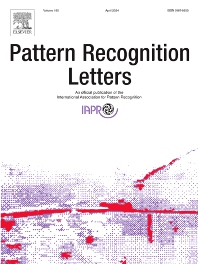Pattern Recognition Letters
- ISSN: 0167-8655
Next planned ship date: May 7, 2024
- 5 Year impact factor: 4.8
- Impact factor: 5.1
An official publication of the International Association for Pattern Recognition Pattern Recognition Letters aims at rapid publication of concise articles of a broad interest in… Read more
Subscription options
Next planned ship date:
May 7, 2024
Institutional subscription on ScienceDirect
Request a sales quoteAn official publication of the International Association for Pattern Recognition
Pattern Recognition Letters aims at rapid publication of concise articles of a broad interest in pattern recognition.
Subject areas include all the current fields of interest represented by the Technical Committees of the International Association of Pattern Recognition, and other developing themes involving learning and recognition. Examples include:
• Statistical, structural, syntactic pattern recognition;
• Neural networks, machine learning, data mining;
• Discrete geometry, algebraic, graph-based techniques for pattern recognition;
• Signal analysis, image coding and processing, shape and texture analysis;
• Computer vision, robotics, remote sensing;
• Document processing, text and graphics recognition, digital libraries;
• Speech recognition, music analysis, multimedia systems;
• Natural language analysis, information retrieval;
• Biometrics, biomedical pattern analysis and information systems;
• Special hardware architectures, software packages for pattern recognition.
We invite contributions as research reports or commentaries.
Research reports should be concise summaries of methodological inventions and findings, with strong potential of wide applications.
Alternatively, they can describe significant and novel applications of an established technique that are of high reference value to the same application area and other similar areas.
Commentaries can be lecture notes, subject reviews, reports on a conference, or debates on critical issues that are of wide interests.
To serve the interests of a diverse readership, the introduction should provide a concise summary of the background of the work in an accepted terminology in pattern recognition, state the unique contributions, and discuss broader impacts of the work outside the immediate subject area. All contributions are reviewed on the basis of scientific merits and breadth of potential interests.
Pattern Recognition Letters aims at rapid publication of concise articles of a broad interest in pattern recognition.
Subject areas include all the current fields of interest represented by the Technical Committees of the International Association of Pattern Recognition, and other developing themes involving learning and recognition. Examples include:
• Statistical, structural, syntactic pattern recognition;
• Neural networks, machine learning, data mining;
• Discrete geometry, algebraic, graph-based techniques for pattern recognition;
• Signal analysis, image coding and processing, shape and texture analysis;
• Computer vision, robotics, remote sensing;
• Document processing, text and graphics recognition, digital libraries;
• Speech recognition, music analysis, multimedia systems;
• Natural language analysis, information retrieval;
• Biometrics, biomedical pattern analysis and information systems;
• Special hardware architectures, software packages for pattern recognition.
We invite contributions as research reports or commentaries.
Research reports should be concise summaries of methodological inventions and findings, with strong potential of wide applications.
Alternatively, they can describe significant and novel applications of an established technique that are of high reference value to the same application area and other similar areas.
Commentaries can be lecture notes, subject reviews, reports on a conference, or debates on critical issues that are of wide interests.
To serve the interests of a diverse readership, the introduction should provide a concise summary of the background of the work in an accepted terminology in pattern recognition, state the unique contributions, and discuss broader impacts of the work outside the immediate subject area. All contributions are reviewed on the basis of scientific merits and breadth of potential interests.
- ISSN: 0167-8655
- Volume 12
- Issue 12
- 5 Year impact factor: 4.8
- Impact factor: 5.1
Read the Pattern Recognition Letters Guide for Authors, Open Access policy, and latest articles on ScienceDirect
